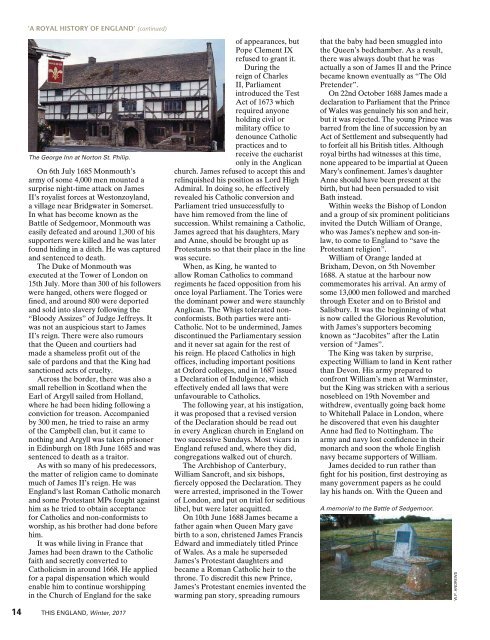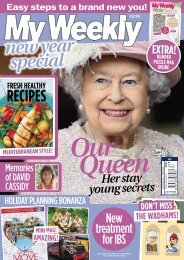This England
This England is the quarterly magazine for all who love our green and pleasant land and are unashamedly proud of their English roots. Published since 1968 the magazine has now become one of England’s best loved magazines and has a readership of over 115,000 people from around the world. As well as being popular in England it outsells all other British heritage magazines in Canada, Australia, New Zealand, South Africa and is sent to readers in every country of the world. Published in Cheltenham, in the heart of picturesque Gloucestershire, the magazine is edited, printed and despatched direct from England. Subscribe today and celebrate all that is best about England and the English way of life.
This England is the quarterly magazine for all who love our green and pleasant land and are unashamedly proud of their English roots. Published since 1968 the magazine has now become one of England’s best loved magazines and has a readership of over 115,000 people from around the world. As well as being popular in England it outsells all other British heritage magazines in Canada, Australia, New Zealand, South Africa and is sent to readers in every country of the world.
Published in Cheltenham, in the heart of picturesque Gloucestershire, the magazine is edited, printed and despatched direct from England. Subscribe today and celebrate all that is best about England and the English way of life.
Create successful ePaper yourself
Turn your PDF publications into a flip-book with our unique Google optimized e-Paper software.
‘A ROYAL HISTORY OF ENGLAND’ (continued)<br />
The George Inn at Norton St. Philip.<br />
On 6th July 1685 Monmouth’s<br />
army of some 4,000 men mounted a<br />
surprise night-time attack on James<br />
II’s royalist forces at Westonzoyland,<br />
a village near Bridgwater in Somerset.<br />
In what has become known as the<br />
Battle of Sedgemoor, Monmouth was<br />
easily defeated and around 1,300 of his<br />
supporters were killed and he was later<br />
found hiding in a ditch. He was captured<br />
and sentenced to death.<br />
The Duke of Monmouth was<br />
executed at the Tower of London on<br />
15th July. More than 300 of his followers<br />
were hanged, others were flogged or<br />
fined, and around 800 were deported<br />
and sold into slavery following the<br />
“Bloody Assizes” of Judge Jeffreys. It<br />
was not an auspicious start to James<br />
II’s reign. There were also rumours<br />
that the Queen and courtiers had<br />
made a shameless profit out of the<br />
sale of pardons and that the King had<br />
sanctioned acts of cruelty.<br />
Across the border, there was also a<br />
small rebellion in Scotland when the<br />
Earl of Argyll sailed from Holland,<br />
where he had been hiding following a<br />
conviction for treason. Accompanied<br />
by 300 men, he tried to raise an army<br />
of the Campbell clan, but it came to<br />
nothing and Argyll was taken prisoner<br />
in Edinburgh on 18th June 1685 and was<br />
sentenced to death as a traitor.<br />
As with so many of his predecessors,<br />
the matter of religion came to dominate<br />
much of James II’s reign. He was<br />
<strong>England</strong>’s last Roman Catholic monarch<br />
and some Protestant MPs fought against<br />
him as he tried to obtain acceptance<br />
for Catholics and non-conformists to<br />
worship, as his brother had done before<br />
him.<br />
It was while living in France that<br />
James had been drawn to the Catholic<br />
faith and secretly converted to<br />
Catholicism in around 1668. He applied<br />
for a papal dispensation which would<br />
enable him to continue worshipping<br />
in the Church of <strong>England</strong> for the sake<br />
of appearances, but<br />
Pope Clement IX<br />
refused to grant it.<br />
During the<br />
reign of Charles<br />
II, Parliament<br />
introduced the Test<br />
Act of 1673 which<br />
required anyone<br />
holding civil or<br />
military office to<br />
denounce Catholic<br />
practices and to<br />
receive the eucharist<br />
only in the Anglican<br />
church. James refused to accept this and<br />
relinquished his position as Lord High<br />
Admiral. In doing so, he effectively<br />
revealed his Catholic conversion and<br />
Parliament tried unsuccessfully to<br />
have him removed from the line of<br />
succession. Whilst remaining a Catholic,<br />
James agreed that his daughters, Mary<br />
and Anne, should be brought up as<br />
Protestants so that their place in the line<br />
was secure.<br />
When, as King, he wanted to<br />
allow Roman Catholics to command<br />
regiments he faced opposition from his<br />
once loyal Parliament. The Tories were<br />
the dominant power and were staunchly<br />
Anglican. The Whigs tolerated nonconformists.<br />
Both parties were anti-<br />
Catholic. Not to be undermined, James<br />
discontinued the Parliamentary session<br />
and it never sat again for the rest of<br />
his reign. He placed Catholics in high<br />
offices, including important positions<br />
at Oxford colleges, and in 1687 issued<br />
a Declaration of Indulgence, which<br />
effectively ended all laws that were<br />
unfavourable to Catholics.<br />
The following year, at his instigation,<br />
it was proposed that a revised version<br />
of the Declaration should be read out<br />
in every Anglican church in <strong>England</strong> on<br />
two successive Sundays. Most vicars in<br />
<strong>England</strong> refused and, where they did,<br />
congregations walked out of church.<br />
The Archbishop of Canterbury,<br />
William Sancroft, and six bishops,<br />
fiercely opposed the Declaration. They<br />
were arrested, imprisoned in the Tower<br />
of London, and put on trial for seditious<br />
libel, but were later acquitted.<br />
On 10th June 1688 James became a<br />
father again when Queen Mary gave<br />
birth to a son, christened James Francis<br />
Edward and immediately titled Prince<br />
of Wales. As a male he superseded<br />
James’s Protestant daughters and<br />
became a Roman Catholic heir to the<br />
throne. To discredit this new Prince,<br />
James’s Protestant enemies invented the<br />
warming pan story, spreading rumours<br />
that the baby had been smuggled into<br />
the Queen’s bedchamber. As a result,<br />
there was always doubt that he was<br />
actually a son of James II and the Prince<br />
became known eventually as “The Old<br />
Pretender”.<br />
On 22nd October 1688 James made a<br />
declaration to Parliament that the Prince<br />
of Wales was genuinely his son and heir,<br />
but it was rejected. The young Prince was<br />
barred from the line of succession by an<br />
Act of Settlement and subsequently had<br />
to forfeit all his British titles. Although<br />
royal births had witnesses at this time,<br />
none appeared to be impartial at Queen<br />
Mary’s confinement. James’s daughter<br />
Anne should have been present at the<br />
birth, but had been persuaded to visit<br />
Bath instead.<br />
Within weeks the Bishop of London<br />
and a group of six prominent politicians<br />
invited the Dutch William of Orange,<br />
who was James’s nephew and son-inlaw,<br />
to come to <strong>England</strong> to “save the<br />
Protestant religion”.<br />
William of Orange landed at<br />
Brixham, Devon, on 5th November<br />
1688. A statue at the harbour now<br />
commemorates his arrival. An army of<br />
some 13,000 men followed and marched<br />
through Exeter and on to Bristol and<br />
Salisbury. It was the beginning of what<br />
is now called the Glorious Revolution,<br />
with James’s supporters becoming<br />
known as “Jacobites” after the Latin<br />
version of “James”.<br />
The King was taken by surprise,<br />
expecting William to land in Kent rather<br />
than Devon. His army prepared to<br />
confront William’s men at Warminster,<br />
but the King was stricken with a serious<br />
nosebleed on 19th November and<br />
withdrew, eventually going back home<br />
to Whitehall Palace in London, where<br />
he discovered that even his daughter<br />
Anne had fled to Nottingham. The<br />
army and navy lost confidence in their<br />
monarch and soon the whole English<br />
navy became supporters of William.<br />
James decided to run rather than<br />
fight for his position, first destroying as<br />
many government papers as he could<br />
lay his hands on. With the Queen and<br />
A memorial to the Battle of Sedgemoor.<br />
W.P. ANDREWS<br />
14 THIS ENGLAND, Winter, 2017
















